15-Minute EASY Vegan Tteokbokki – Spicy Korean Rice Cakes.
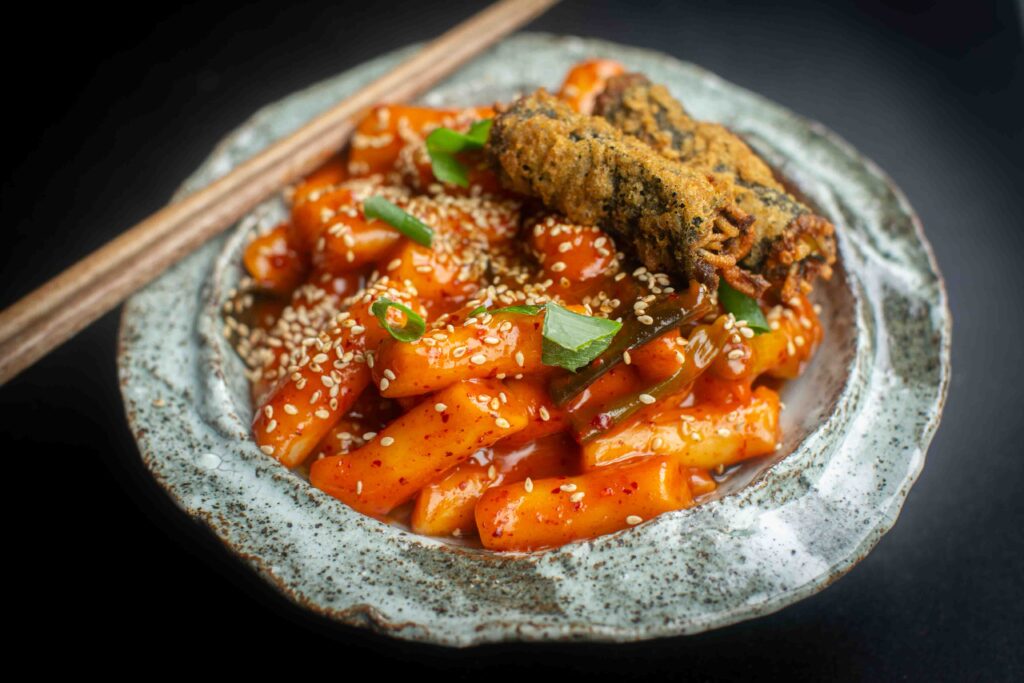
Spicy. Chewy. Addictive.
Welcome to vegan tteokbokki.
If you’re at all familiar with Korean cuisine, then you’re no stranger to the many allures of spicy tteokbokki. There’s a reason why Wikipedia dubs tteokbokki as “one of Korea’s most popular snack foods.” This version of tteokbokki is made of chewy rice cakes that are drenched in a sweet and savory and spicy sauce. As it were, this most popular Korean street food is already 90% vegan, which means this vegan tteokbokki is almost identical to what you’ll find at Korean markets or on the seething streets of South Korea.
If you like spicy food, this one’s DEFINITELY for you.
So, without further ado, let’s get into it!
What Even is Tteobokki?
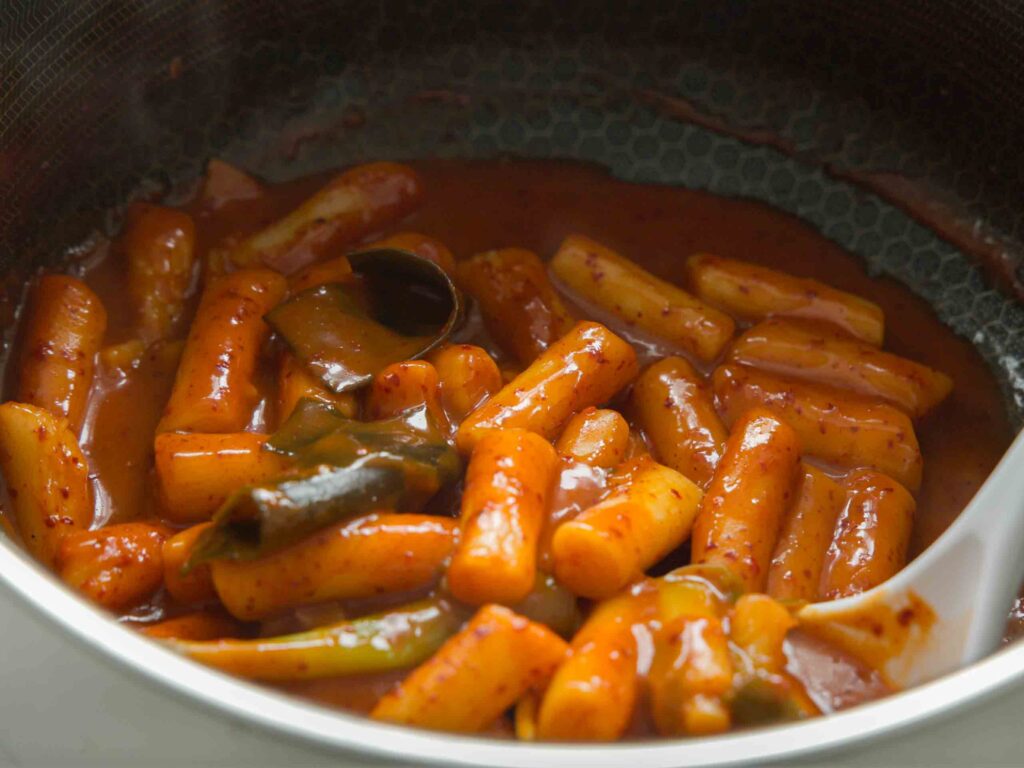
Tteokbokki literally means rice cake (“tteok” or 떡) that is stir-fried (“bokki” or 볶이).
Contrary to popular belief, not all tteobokki or “fried rice cakes” are spicy. There are generally two preparations of tteokbokki: the spicy kind (which we’re making here) and the non-spicy kind (sometimes referred to as “gunjung” or “palace” tteokbokki). The version going viral on social media is undoubtedly the spicy, bright red, fiery preparation.
Spicy tteokbokki is often the subject of really popular mukbangs featuring sweaty faced individuals trying to prove their mettle by downing large quantities of painfully spicy rice cakes. Indeed, there are famous Korean restaurants in both the United States and Korea that are known for just how treacherously spicy their tteokbokki can be!
But what do these Korean spicy rice cakes taste like?
The rice cakes are made by steaming finely ground white rice (though you can also sometimes find rice cakes made with brown rice). They are seasoned with a little salt and sometimes some sesame oil. They are naturally gluten free. The rice cakes themselves possess chewy texture (they’re not crunchy like Western style rice cakes!), similar to mochi or gnocchi. They have almost no discernible taste, which is why they are smothered in sauce.
The spicy tteokbokki sauce is made out of three main ingredients: gochujang (Korean chili paste), gochugaru (Korean chili flakes), and sweetener. It is thus spicy, savory, and a little a sweet, a little like the sauce for your pasta arrabbiata.
While traditional tteokbokki is prepared with a spicy gravy or with soy sauce, these days, you can find all sorts of inventive sauces for tteokbokki, including rosé tteokbokki, jjajang tteokbokki, and curry tteokbokki. My book even has a recipe for Tteokobkki Arrabbiata, based on a spicy tomato sauce!
Why You’ll Love This Recipe For Spicy Vegan Tteokbokki.
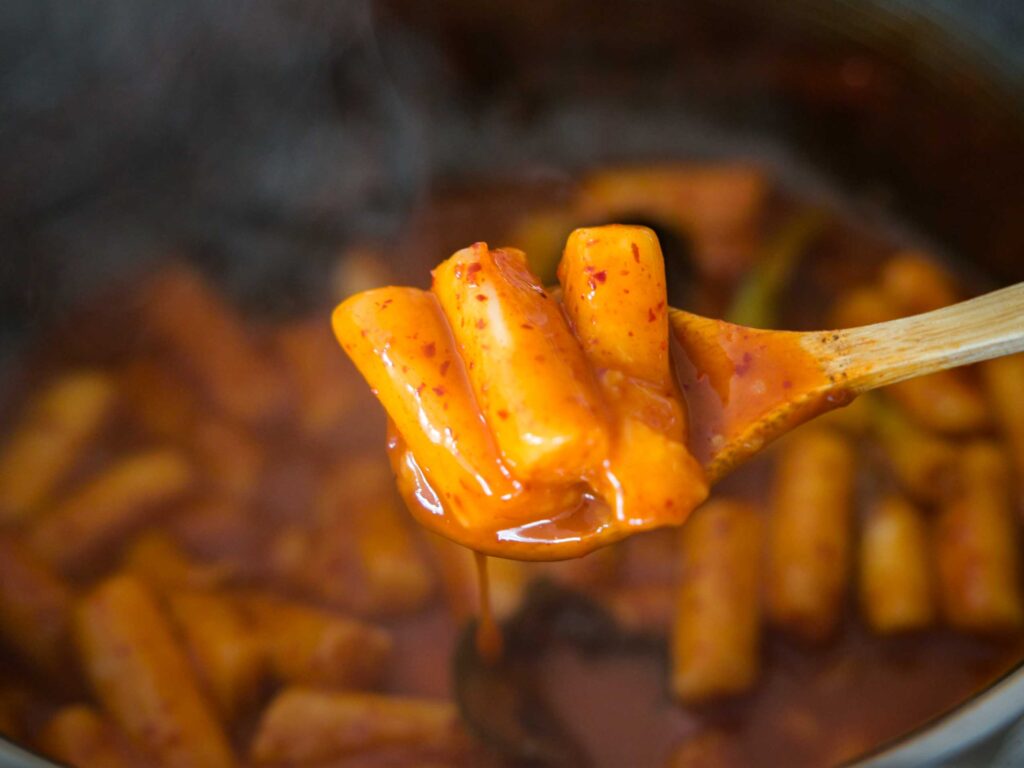
Because it’ll take you 15 minutes to make, from start to finish.
Because it has less than 10 ingredients.
Because it’s absolutely freaking delicious.
This vegan tteokbokki is so easy to make, you’ll be able to whip it up for your next dinner party and wow your guests, or wow yourself whenever you’re craving a delicious late-night snack (especially during the colder months).
As I mentioned earlier, traditional tteokbokki is already mostly vegan. In this vegan tteokbokki recipe, we’ll make a couple of tweaks to make sure it’s 100% vegan and thus a suitable addition to your library of favorite vegan recipes.
Ingredients & Substitutions for Spicy Vegan Tteokbokki.
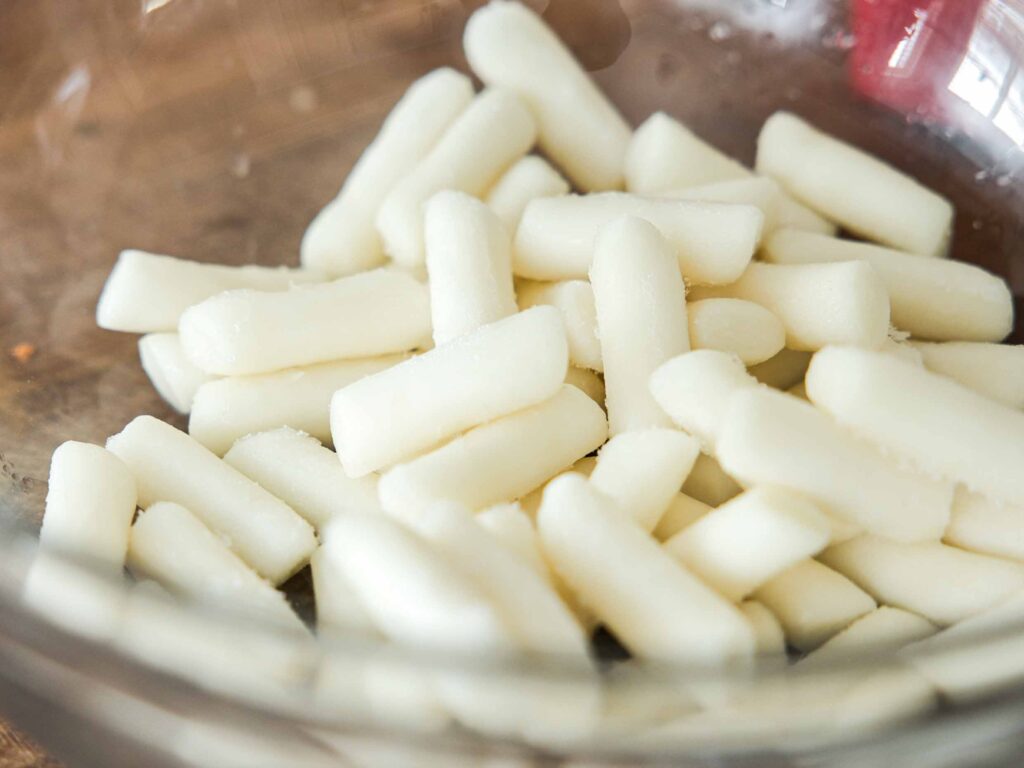
The following provides a description of the key ingredients for this vegan tteokbokki, along with notes on potential substitutions:
- Tteok or Rice Cakes. Do NOT confuse these for those crunchy, cinnamon dusted rice cakes you’ll find in the breakfast aisle of your Western style grocery store (that happened to me once–a shopper for a TV segment I was doing brought me crunchy rice cakes). These rice cakes will only be available in Asian supermarkets. You can find them frozen (always), refrigerated (usually), or fresh (only in the Korean markets and if it’s later in the day). The rice cakes will usually come in two shapes: cylindrical (like the photo) or in discs. The latter is used for soups, while the former (tubes) are for tteokbokki, including this vegan tteokbokki. If you can’t find the tubes, you can always substitute with the discs or any other available shape. If you can’t find rice cakes, then you can always try making them with rice paper sheets.
- Sesame Oil. Toasted sesame oil (not the cold pressed kind) will help to tenderize and flavorize (is that a word?) your rice cakes. A little goes a long way, so you won’t need a lot. You can find my favorite Korean sesame oil here. If you don’t have sesame oil, you can skip the marination altogether and simply add an extra helping of toasted sesame seeds as garnish.
- Gochugaru. Gochugaru or Korean pepper flakes provide both heat and a sweet smokiness to the spicy sauce. You can also modify the spice level with the kind and amount of gochugaru you add to your vegan tteokbokki recipe. Sometimes, if you look closely at the packaging of the gochugaru you purchased, it will tell you just how spicy it is! If you can’t get your hands on gochugaru, you can substitute with gochujang (below), while reducing the amount of sweetener to compensate for the sweetness of the paste.
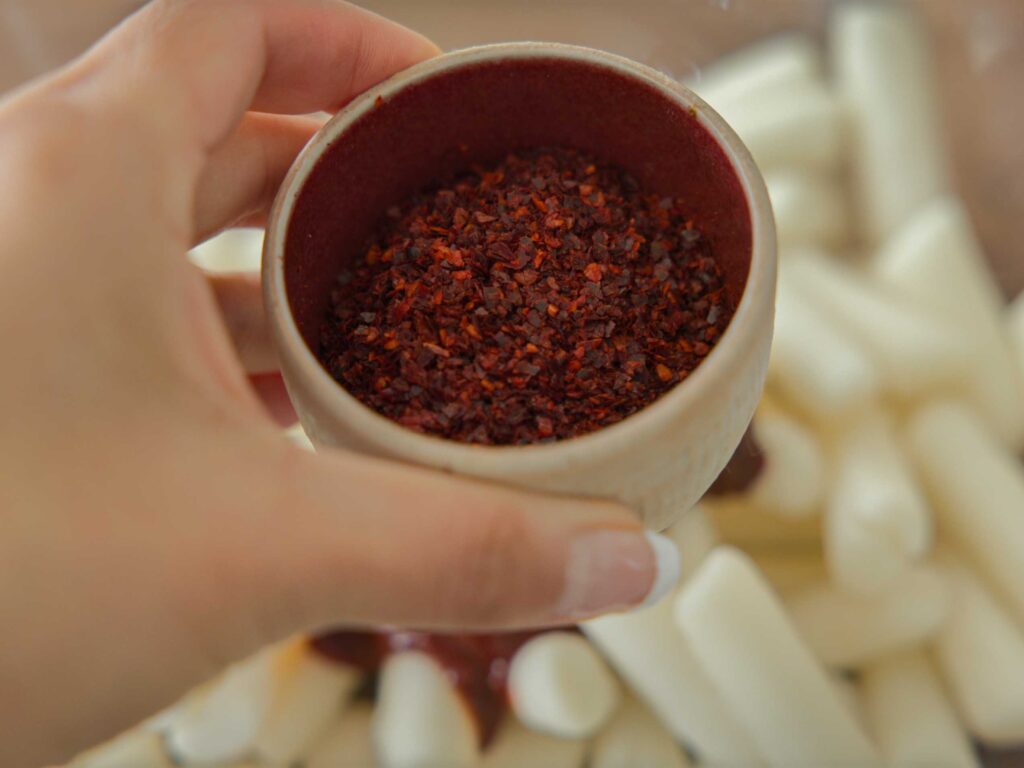
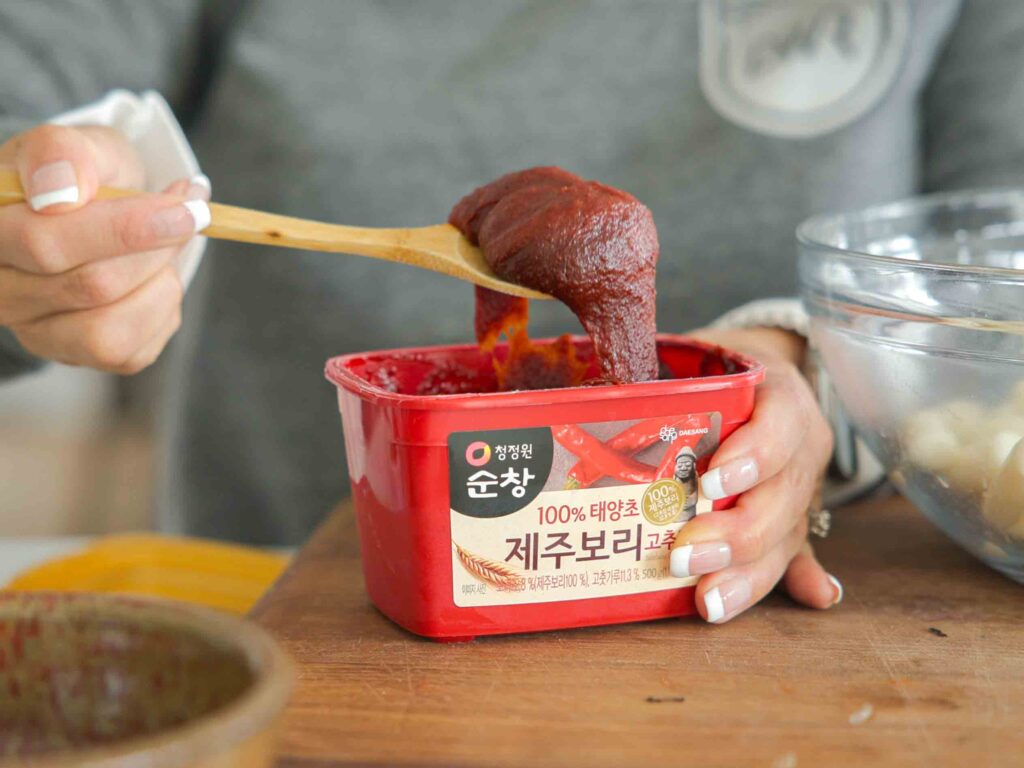
- Gochujang. Gochujang or Korean pepper paste provides intense umami flavor (the paste is made of fermented soybeans), more heat, and a little sweetness. There is no substitute for gochujang in this vegan tteokbokki recipe. If you want to make spicy tteokbokki, you need gochujang.
- Dashima. Dashima or dried kelp will ensure that the rice cakes cook in a broth that mimics the anchovy broth (the one thing that makes traditional tteokbokki not vegan). If you can’t get your hands on some dashima, you can substitute kelp powder or a couple dried shiitake mushrooms.
- Scallions. In addition to dashima, you’ll be using scallion whites for our broth. I like scallions because they’re dual purpose–use the whites for the broth, use the greens for garnish. If you don’t have scallions, though, you can always substitute the scallion whites with regular onion and the scallion greens with your chives.
- Sweetener. The sauce for spicy tteokbokki is a sweet sauce. For my savory dishes, I try to avoid refined sugar and instead use a syrup, like maple syrup, brown rice syrup, agave syrup. You can use whatever sweetener you have on hand.
Tip: If you want to keep your spicy vegan tteokbokki gluten-free, make sure to pick up gluten-free gochujang!
How to Make Spicy Vegan Tteokbokki.
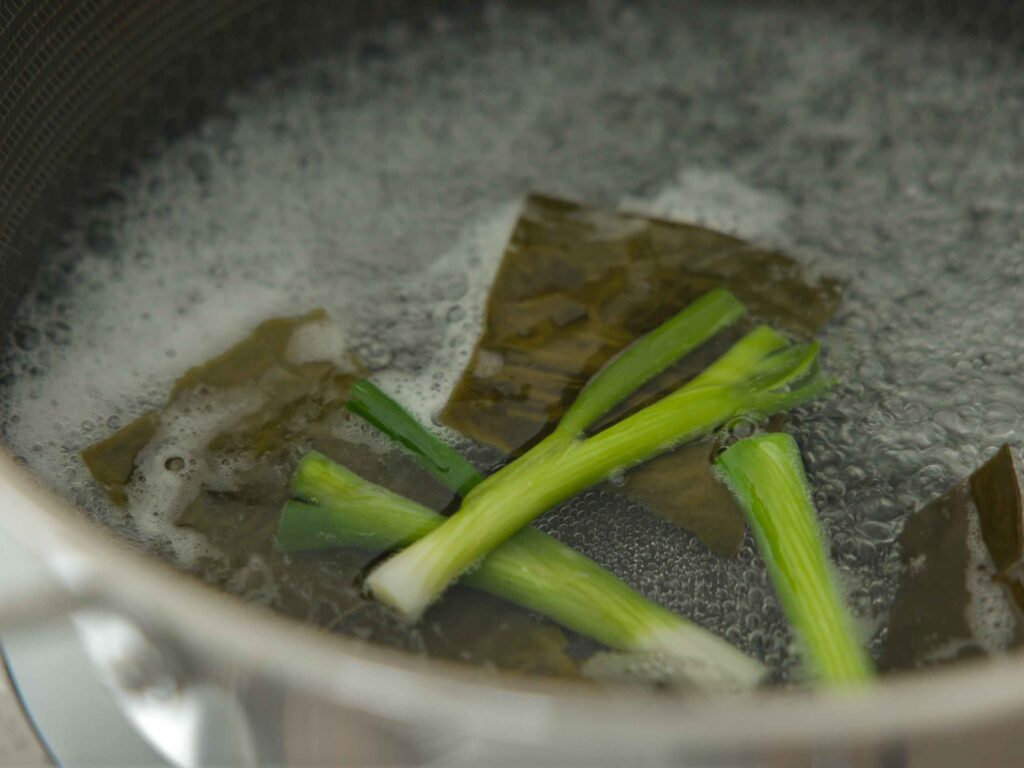
Like I said, this spicy vegan tteokbokki recipes is about as easy it gets.
First, get your broth going: add 2 1/2 cups of water to a deep, large pan or pot (you can substitute vegetable broth if you want to get fancy) over high heat, together with the dashima and scallion whites until it comes to a boil.
While you’re waiting for your water to boil, prep your rice cakes. If you bought them frozen, make sure to take them out of the freezer and thaw them in the fridge the night before. Then, place your thawed, refrigerated, or fresh rice cakes in a large bowl with a little sesame oil, black pepper, gochugaru, and gochujang. Stir the rice cakes until they are evenly coated. This will not only help to tenderize your rice cakes, they will be infused with the rich, nutty flavor of sesame oil, as well as the smoke and heat of the gochujang and gochugaru.
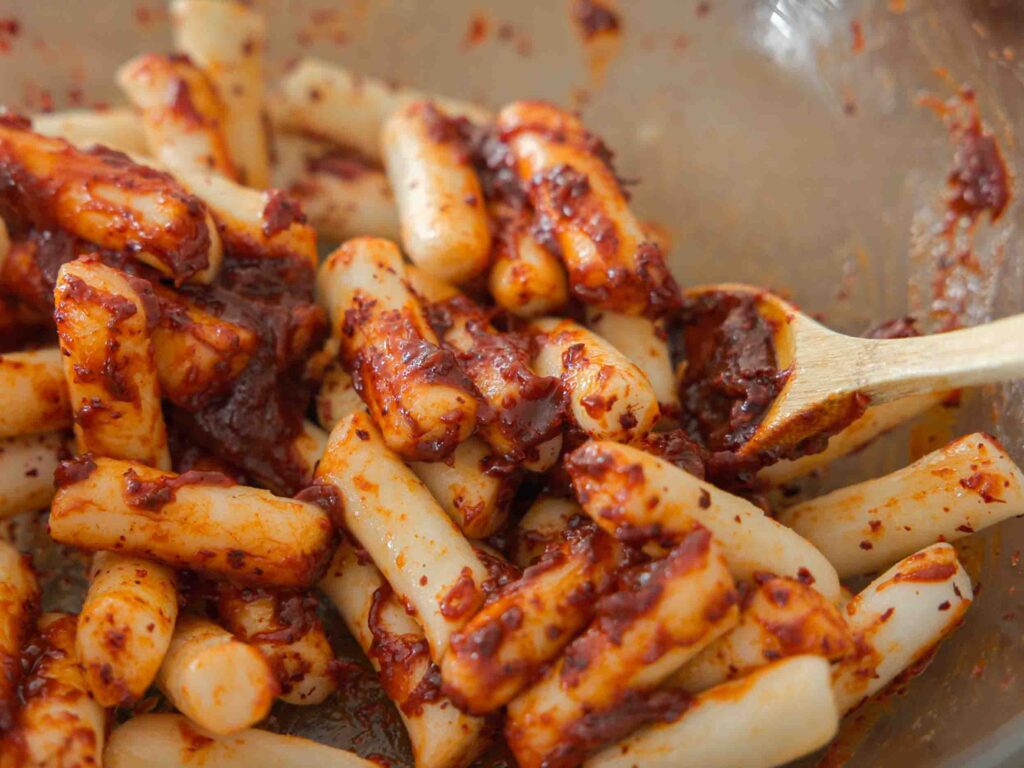
When the water comes to a boil, add your marinated rice cakes, together with more gochujang. Continue cooking over medium-high heat until the rice cakes are super tender and the sauce has reduced to a thick stew-like consistency (about 5 minutes). Add your sweetener (e.g. maple syrup, brown rice syrup, agave, etc.) and stir until incorporated.
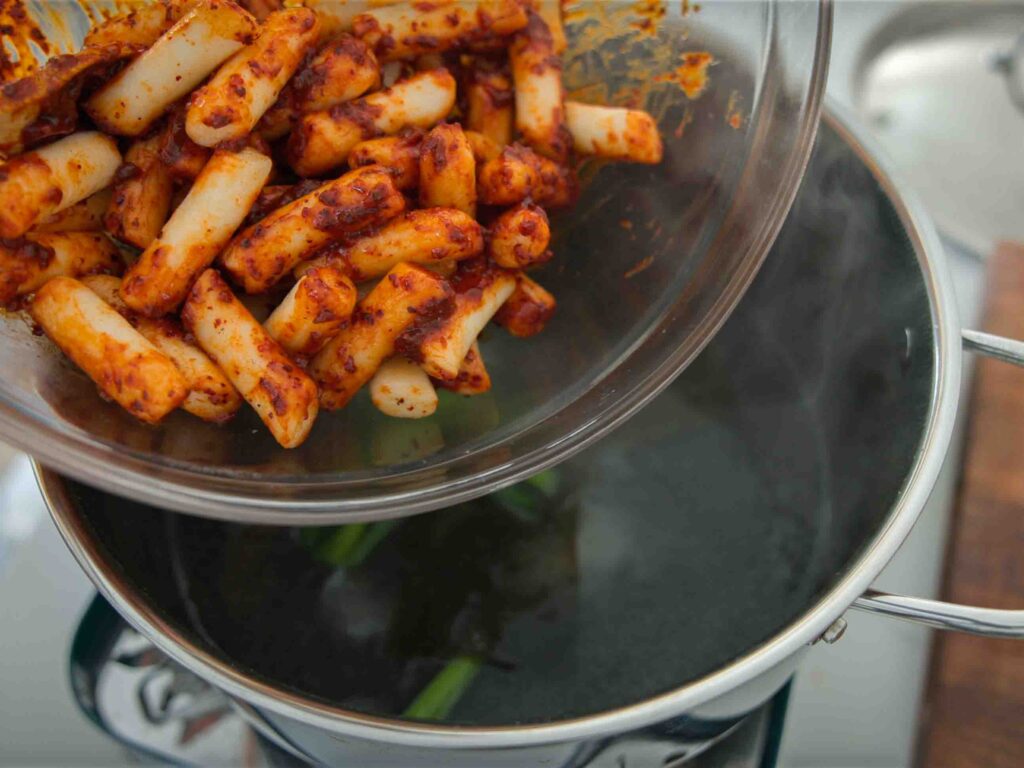
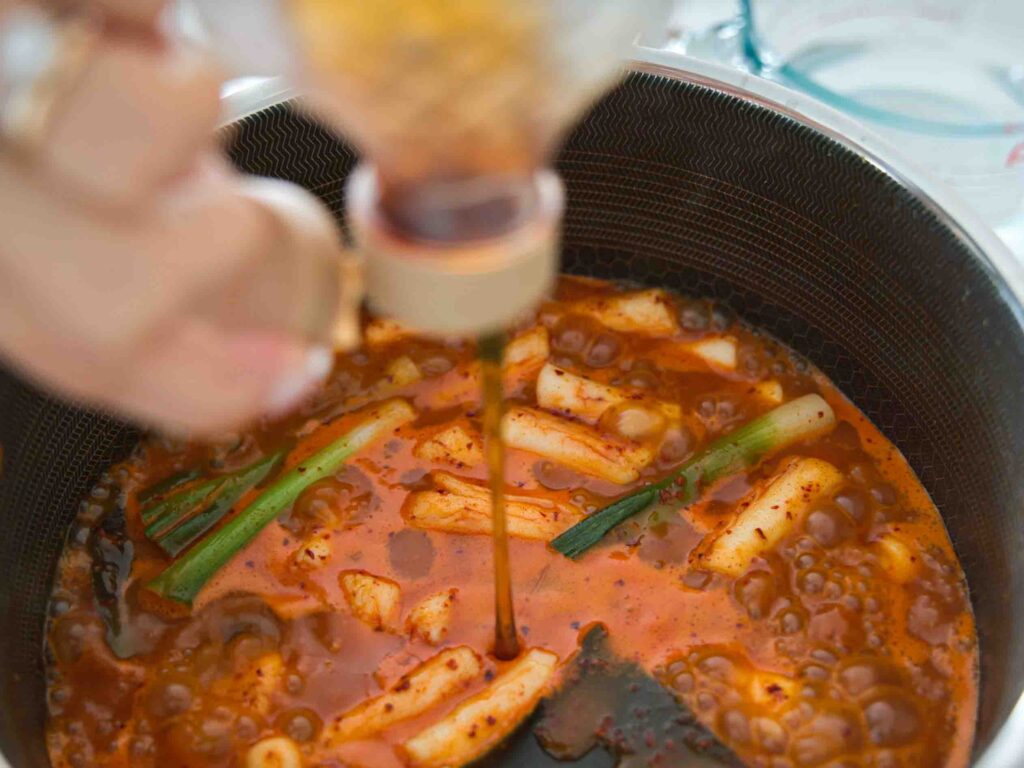
Garnish with fresh scallion greens, toasted sesame seeds, a crack or two of fresh black pepper, and a drizzle of sesame oil.
Voila! Easy, peasy, 15-minute spicy vegan tteokbokki!
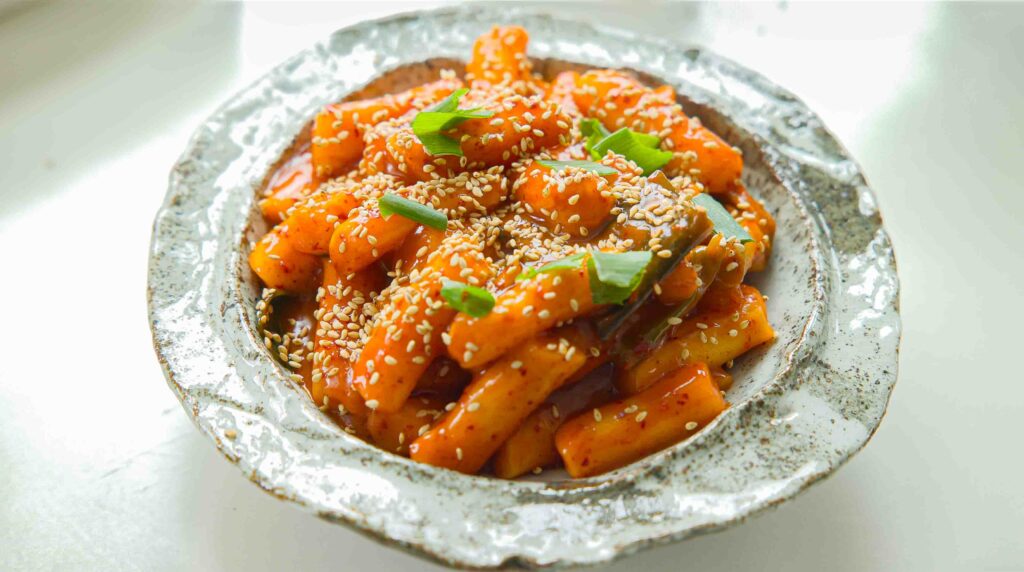
Fun Add-Ons for Spicy Vegan Tteokbokki.
Ok, now that you’ve mastered this easy vegan tteokbokki, you can amp it up with some fun and fancy add-ons:
- Ramen Noodles. Ramen noodles are such a popular add-on to tteokbokki it even has its own name: “rabokki.” Throw these in at the same time you add your rice cakes to the hot water. You can even throw in the little broth packet–trust me, it’ll definitely elevate your tteokbokki game!
- Dangmyeon. I love adding dangmyeon or sweet potato vermicelli to everything, including tteokbokki! As with the ramen noodles, you can throw a handful in when you add the rice cakes to the hot water. However, they will take a little longer to cook–don’t worry. The rice cakes don’t overcook easily (unlike pasta) and can handle the extra time in their hot bath!
- Fried Stuff. Fried dumplings and tempura (breaded and fried vegetables) are a very popular add-on to tteokbokki. I love adding sweet potato tempura to my spicy tteokbokki. These items will need to be cooked separately from the tteokbokki and added after plating.
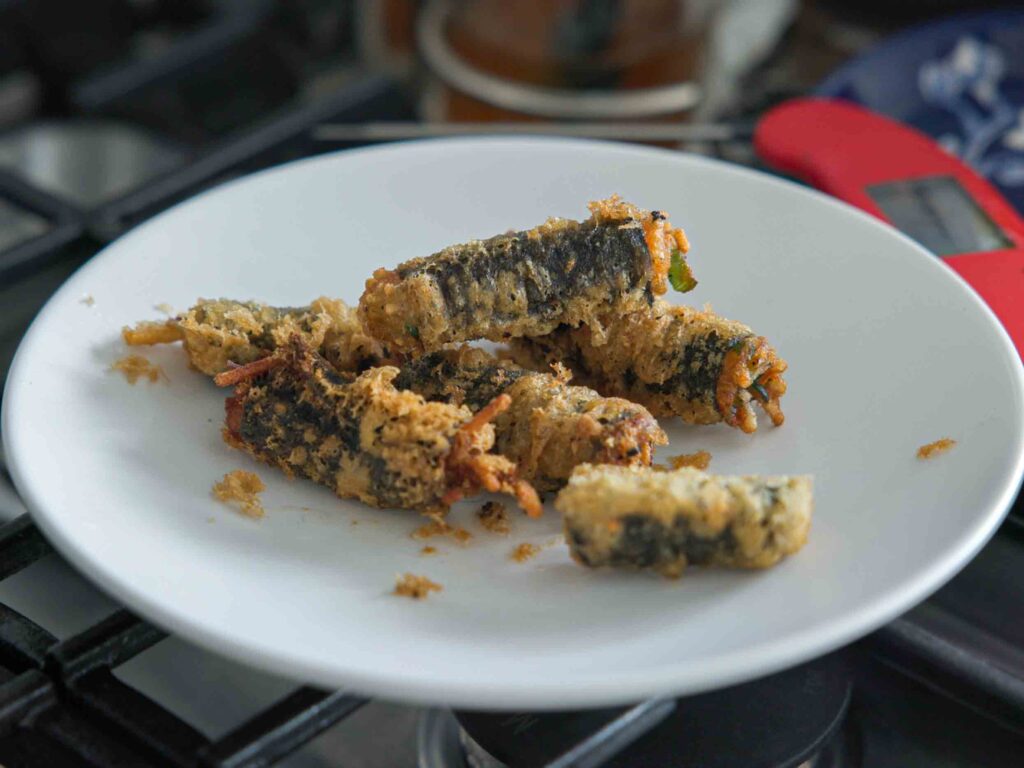
- Fried Tofu Skins. Fish cakes or “odeng” are usually added to traditional tteokbokki. For this vegan tteokbokki, you can use fried tofu skins! They do a remarkable job of mimicking the texture of fish cake and also soak up that delicious sauce.
- Vegetables. I wanted to keep this vegan tteokbokki recipe simple and very similar to the version you’d find on the streets of Korea; but, if you have the time, sauté your favorite vegetables (zucchini, carrots, onions, cabbage, kale, broccoli) in a little oil and throw them into the pot when your rice cakes are tender. Stir everything together and you’ve got yourself a full-blown meal!
Storing Your Vegan Tteokbokki.
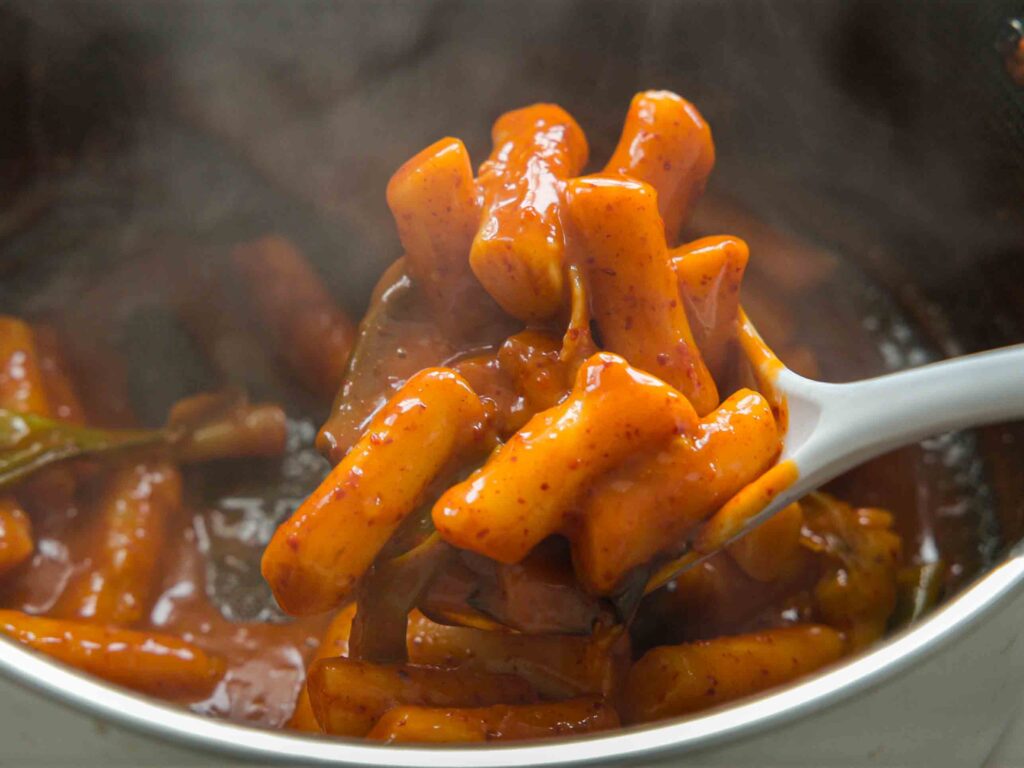
Ideally, you’ll serve and eat your vegan tteokbokki immediately. You’ll discover that leftovers are a bit of nuisance with this recipe, since the rice cakes will get hard and stale about an hour after they are cooked (sometimes even sooner, if you used frozen). If you do have leftovers, store them in an airtight container in the refrigerator for up to three days. You can reheat them by adding a little water and zapping them in the microwave until they are nice and hot or over the stovetop.
Frequently Asked Questions.
What Korean rice cakes are vegan?
For purposes of making tteokbokki, the overwhelming majority of rice cakes are vegan, no matter what shape or size, frozen or fresh. The only exception to this is prepackaged tteokbokki–the kind that comes with the sauce already made.
What is a vegan substitute for Korean fish cake?
As discussed in the add-ons section, fried tofu skins are a great substitute for Korean fish cakes when making vegan tteokbokki.
Do I need to add a thickener or starch to my spicy tteokbokki sauce?
No! The magic of rice cakes is that they will, over time, emit their own starches, naturally thickening your sauce into a stew or even gravy like consistency.
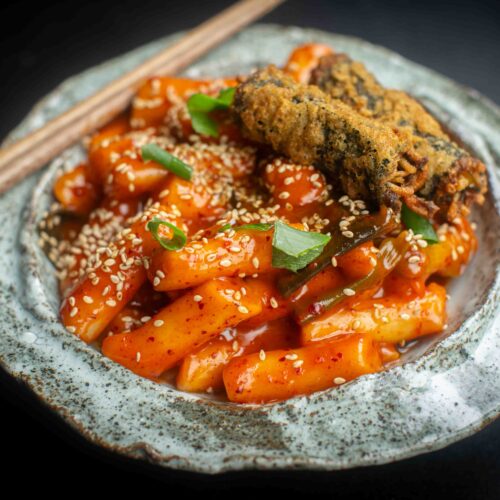
15-Minute Spicy Vegan Tteokbokki.
Ingredients
- 4 2 x 2-inch pieces dashima
- 2 scallions, whites and greens separated and chopped
- 1 tbsp toasted sesame oil, plus more for garnish
- 16 ounces Korean rice cakes (cylindrical)
- 1 tsp cracked black pepper, plus more for garnish
- 2 tbsp gochugaru
- 1/4 cup gochujang
- 2 tbsp brown rice syrup
- 2 tbsp toasted sesame seeds
Instructions
- Add dashima and scallion whites to 2 1/2 cups of water in a deep pan or pot and bring to a boil.
- While water is coming to a boil, add sesame oil, black pepper, gochugaru, and 2 tablespoons of gochujang to the rice cakes (they should be thawed if you're using frozen). Stir until the rice cakes are evenly coated and set aside.
- When the water has come to a boil, add your rice cakes to the water, along with remaining gochujang. Cook for about 5 minutes, until the rice cakes are tender and the sauce has reduced to a thick stew consistency. Add your maple syrup and continue stirring until incorporated.
- Garnish with scallion greens, sesame seeds, black pepper, and a drizzle of sesame oil.
April 15, 2024
Join The Discussion
April 15, 2024
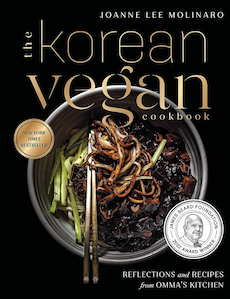
i know this is an oldish post but just wanted to say it’s fantastic.
some optional changes/additions:
tried it with grated garlic and a garlic infused sesame “stir fry oil”; both worked great.
added perilla oil along with the sesame oil.
cutting the gocugaru to 1 tbsp kept the burn down without affecting the flavor too much.
added thinly sliced regular onions along with the scallions in the broth. they basically liquify.
in any case: 10/10. thanks.
Okja! What a great name! Thank you for your suggestions. I love the idea of adding perilla oil and adding thinly sliced onions. That sounds delicious and what an umami punch!! Thank you so much!!
Made this a few weeks ago and making it again tonight. Very authentic and delicious.
Where is the original recipe? I loved the first one. This one tastes very different and has different directions, too.
Yes, I would also love the original recipe too😭 I would always reference it every time I made tteokbokki.
I used the waybackmachine website to find the old version – I refer back to this recipe often 🙂
Is there anywhere I can find the old recipe you had before posting the revised version? 🙂
My son is allergic to sesame, what would use to replace sesame seeds and oil ?
I would suggest peanut oil
Great suggestion!
Just made these for breakfast and it’s delicious! Thank you for sharing!
Awww, thanks makes me so happy!! This is one of my most popular recipes, and like most of them, this is so easy to make!!
Saved!
I just love ddukbokee ever since my Korean friend took me to a Korean food place :v
Since Im Vegan now, this is the perfect recipe
Thanks 🙂
Yay! And it is HELLA easy!!